Beijing-based art collector Tong Bingxue today voiced his concerns on Twitter over the authenticity of a piece currently on auction at Sotheby's. We love ourselves a good old China mystery (especially when it possibly is around false advertising) and were quickly able to not only confirm suspicions over the provenance of "the earliest known dated photograph by a Chinese photographer" but uncover a shocking lack of research and fact-checking across reputable auction houses such as Christie's, Sotheby's as well as publications like the South China Morning Post. Below is an extended breakdown of our analysis based on our original Twitter thread.

Background

The description of the item from Sotheby's is as follows:
"Lai Chong Studio General Ko-Lin, Dated Xianfeng 3rd year, corresponding to 1853 上海麗昌照相號 僧格林沁肖像照 手工上色銀版攝影 咸豐三年(1853年) Sixth-plate daguerreotype, the photographer’s letterpress studio leaf, inscribed with ink to the reverse in French reading [___] le 1er aout 1853, in Chinese reading Daqing xianfeng sannian bayue zhenghuangqi tongsuai gelin jiangjun (Made in the 3rd year of Xianfeng, for the Plain Yellow Banner General Ko-Lin) and in English reading Made by Lai Chong, Portrait of Mogal General Ko-Lin 1853, cased, 1853"
The Sotheby description of the alleged photographer Lai Chong states:
"Very little is known about photographer Lai Chong. Due to the prohibitively high cost of establishing a photographic studio, as well as the tumultuous Chinese political environment in the mid-to-late 19th century, success would have been beyond the scope of ability for all but the most resourceful and skilled individuals."
The provenance is given as follows:
- Hong Kong Private Collection, by 1954.
- Collection of H. Kwan Lau.
- Christie’s London, 19th October 1994, lot 1.
Our Analysis
1. Lai Chong Photo, Co
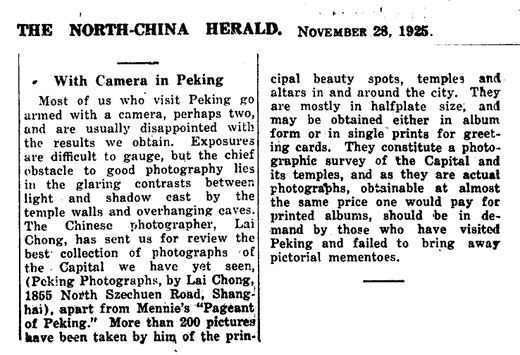
Contrary to Sotheby's description Lai Chong (麗昌) was a rather well-known photographer and photo studio owner with multiple locations across China (possibly in Shanghai, Guling, Xi'an, Liaocheng and Fuzhou). We can find numerous mentions in address directories, newspaper reports, press picture credits as well as on actual original photos and postcards throughout the mid 1910s to the early 1930's.
A North-China Herald news report from 28 Nov 1925 for example mentions a photographer called Lai Chong who is listed under the same address visible underneath the blackened parts of the photo on the backside of the daguerreotype frame: No 1855 North Szechuen Road, Shanghai. Szechuen Road was formerly called Bridge Street and was only renamed in the year 1865. Below the address appears to be written "Close to Apollo Theatre" - a Shanghai theatre opened in 1910. It is therefore impossible that the frame or label is from 1853.


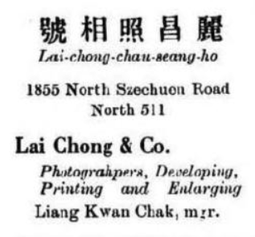
In fact we can date the photograph (or the alterations by Lai Chong thereof) to either between 1906 and 1915 or 1924 and 1925 which, based on Hong List address records and advertisements, were the only times Lai Chong Photo Co resided at 1855 North Szechuen Road in Shanghai.
Most likely the photo was thus taken during his November 1925 Beijing trip, mentioned in the North-China Herald article. There remains the question however, if the picture was an actual portrait or a reproduction of a previously existing photo.
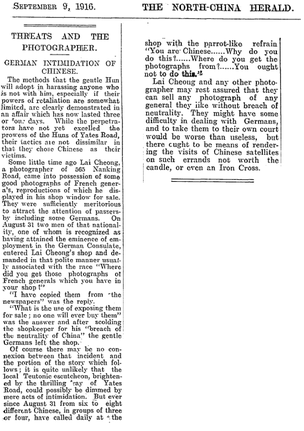
The reason we suspect the latter, is because the Shanghai-based photographer Lai Ch(e)ong actually had a reported history of creating photographic reproductions of images displaying generals (!).
"I have copied them from the newspapers", he is quoted in a September 9th, 1916 article from The North-China Herald, when confronted by two Germans in Shanghai about photos of French generals displayed in his photo studio, then located at 565 Nanking Road.

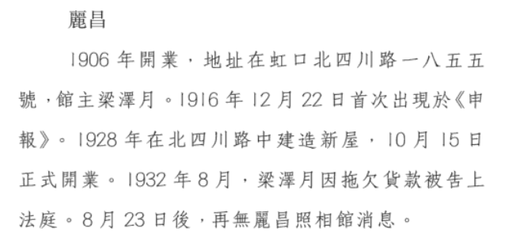
Further evidence that Lai Chong was active in the early 20th century in Shanghai and up to the early 1930s is provided by a short biography in the Chinese book "History of Chinese Photo Studios (1859-1956)" / 中國照相館史 (1859-1956):
"Lai Chong's [studio] opened in 1906. The address was at No. 1855, Sichuan Road, North in Hongkou. The manager of the branch was Liang Zeyue (梁澤月). It [the studio] is first mentioned in the Shun Pao newspaper (申報) on December 22, 1916. In 1928, a new building was constructed on North Sichuan Road, and it officially opened on October 15th. In August 1932, Liang Zeyue was brought to court for arrears in payment for goods. After August 23, no further news of Lai Chong Photo Studio are found." [indicating it became insolvent and was shut]
2. General "Ko-Lin"

No records of a General Ko-Lin have been found, which is not surprising since there almost certainly never was a General called Ko-Lin. Instead Lai Chong, apart from his Shanghai studio, had a second location in Kuling (牯嶺)/ today's Guling, which is clearly stated in the original Chinese description (as well as in English) on the back of the picture frame. Kuling at that time was pronounced "koo lin" in English.
Why would a Chinese photographer open a studio in the remote town of Kuling? Well, Guling, then called Kuling, on the slopes of a wide valley of Mountain Lu, was established 1895 (!) by the missionaries Edward Selby Little & Dr. Edgerton Hart who likely taught some of the locals photography and inspired Lai Chong to take up the profession and eventually move to Shanghai for business. Or as other sources indicate Lai Chong first opened the Shanghai office and later in 1931 opened a second branch in Guling for reasons unknown (that may or may not have been related to his Shanghai studios' bankruptcy in 1932...). Kuling by then had became quite a sizable resort according to Nicholas Kitto and was commonly referred to as "China's Summer Capital" - in 1932 for example it saw over 1,400 foreign summer residents. Not bad potential business for a vacation photographer.
Either way, Kuling did not even exist in 1853 and thus once more the dating of this item is proven to most likely be false.
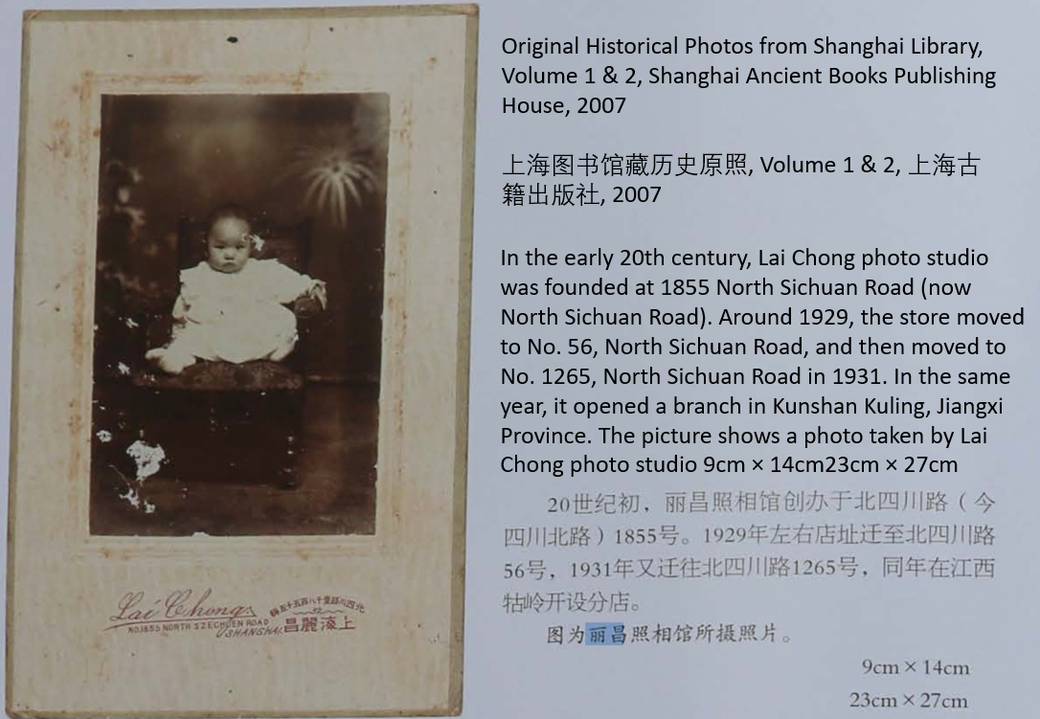
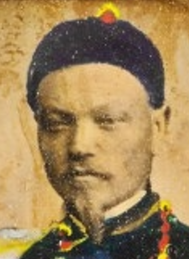
On a side note, the gentleman on the photo looks suspiciously Caucasian, but that is a different story and not for us to judge. It is entirely possible though, that the picture is a photomontage which, purposefully or not, used a pre-existing or newly taken portrait of a Western man in a recreated or superimposed Qing Dynasty style setting. Photomontages first emerged in the mid-1850s as experimental photographers aspired to create images that could rank alongside fine art. In the beginning of the 20th century it was also not uncommon for Westerners in China to dress up in Chinese traditional clothing for cabinet portraits.
3. The Date 1853

The date 1853 probably stems either from a silly (and rather obvious) prank, a hand written error or a misinterpretation at best of the No 1855 North Szechuen Rd address by the person who made the first annotations on the frame in French (edit: appearing to say "Toulon le 1er oût 1853" - interpretation by Richard in the comments below)- or a deliberate and very amateurish forgery at worst. Two separate repetitions of this false information were then made in English handwriting on the back of the photo. There remains also a small probability that the photo is an actual daguerreotype of a Caucasian man taken by a French photographer in Toulon in 1853, that then made its way to Shanghai in the 1910s or '20s, after which Lai Chong acquired and overpainted it with Chinese clothing and background.
At some point - when it was already too late - someone realized the erroneous dating of the item and blackened the addresses of Lai Chong Studio both in English & Chinese to prevent the accurate dating based on our evidence provided above. Whoever did this, however was apparently not a Chinese native speaker and missed the 北 (North) of 北四川路 (North Sichuan Lu).
As pointed out by Tong Bingxue the piece was first exhibited in Nov. 1984 in Beijing's National Art Museum, when a photo was taken by Chen Shen, which shows that even after that time additional Chinese notes were added on the label.
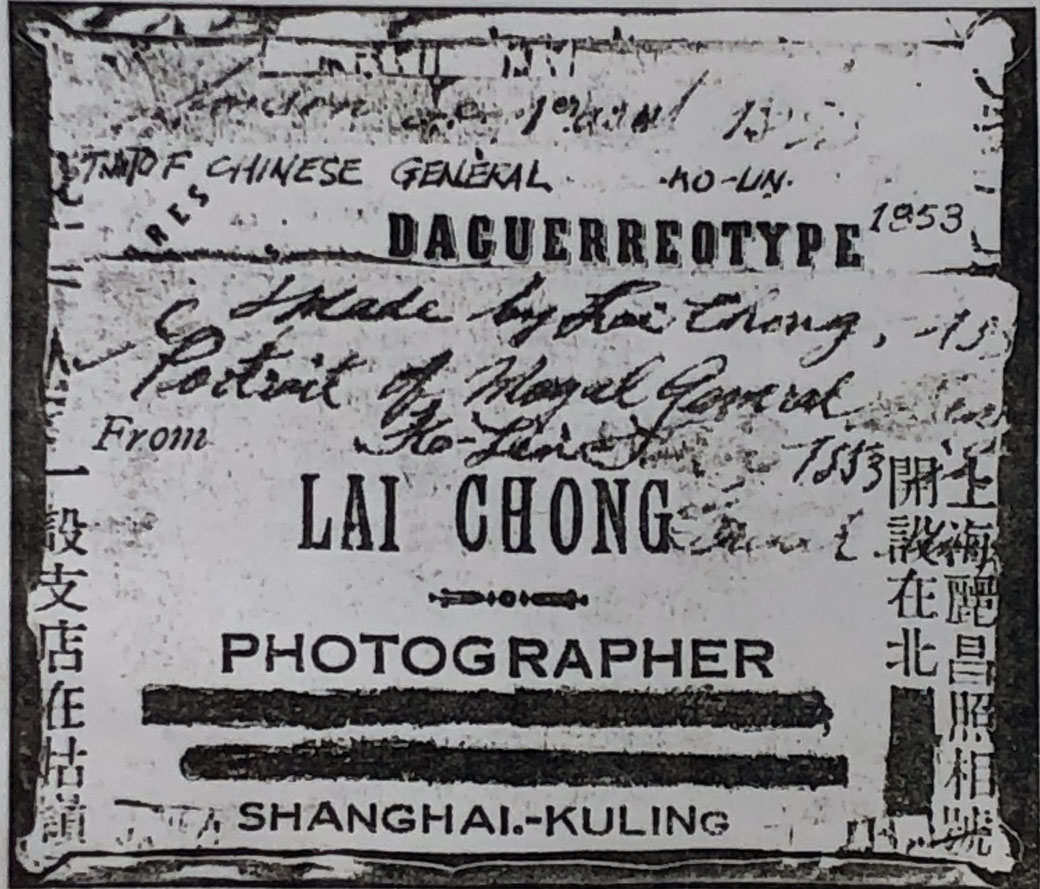
Besides all of the evidence surrounding this particular image, it is almost impossible that Chinese Lai Chong already mastered daguerreotype photography in 1853 when Afong Studio - considered to be the most successful Chinese-owned photographic studio in the late Qing Dynasty - was only founded by Lai Afong (黎芳) in 1870.
Secondly, Daguerreotype photography in fact only reached Shanghai by the way of two separate Western photographers in 1852 and again 1853: Herman Husband and Cesar von Düben, respectively. Dates suspiciously close to the alleged creation of the General "Kuling" photo, and another possible source of confusion causing the false labelling.
Conclusion
In conclusion, while this photo is almost certainly not from 1853, likely was not originally shot by Lai Chong and definitely does not depict a General "Ko-Lin", it is difficult to call it a plain forgery. The hints of deliberate alterations are so obvious and amateurish that instead, this entire story rather represents a highly embarrassing example of poor provenance research by multiple institutions and a cautionary tale for art collectors around the world.
Post Script
Someone who was frequently photographed in traditional Chinese clothes was Sir Reginald Fleming Johnston - famous tutor of "The Last Emperor" Puyi and who was first posted to China in 1906. He also bears quite a resemblance to our General Ko-Lin...
























































Write a comment
RICHARD (Tuesday, 22 March 2022 03:50)
I read at the top of the back the mention "Toulon le 1er oût 1853" (rather than London). At that time the handwritten "T" in French was not systematically crossed out as it is today.
Toulon is a port city and naval base in southern France.
In the 19th century, this port, the largest in the Mediterranean Sea, welcomed traffic in connection with Africa, Asia and Oceania in particular...
... which could explain the French annotations.
Richard from France.
MOFBA (Tuesday, 22 March 2022 04:14)
Thank you very much Richard. The source photo could have been of a French man taken in Toulon in 1853, which was then overpainted with a Qing Dynasty type scene by Lai Chong in the 20th century (possibly mid 1920s). The man depicted does look somewhat Caucasian as mentioned above in our article.